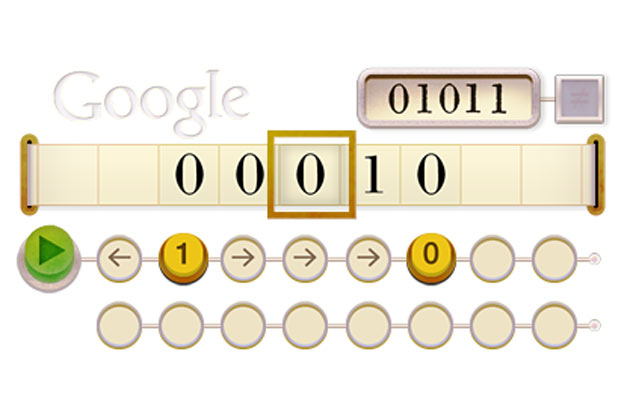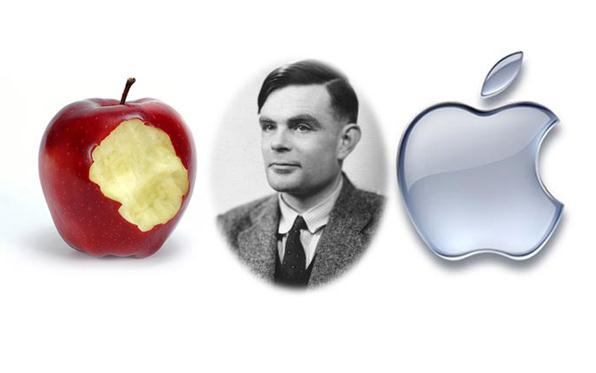Alan Turing Google Doodle: His 100th Birthday
Alan Turing Google Doodle

Click the image to solve the Alan Turing Google Doodle
In 1928 at the age of just 16 Turing came across the work of Albert Einstein. Not only did Turing understand his fellow genius’s work he even extrapolated Einstein’s questioning of Newton’s Law of Motion from a document. What is perhaps most remarkable about this incident is that the document did not make the link explicit.
Turing went on to attend King’s College Cambridge. He studied as an undergraduate there between the years of 1931 and 1934. He gained his first class honours degree in Mathematics. In 1935, aged just 22 Turing was elected as a fellow at King’s. This election was based on the strength of his dissertation whereby he successfully proved the central limit theorem.
In 1938 Turing received his PhD from Princeton University. In his dissertation, “Systems of Logic Based on Ordinals”, he introduced the world to the concepts of ordinal logic and relative computing.
Turing was a leading contributor at Bletchley Park. The site where British scientists and mathematicians successfully broke the German Enigma Code. Whilst here he earned a reputation of eccentricity among his colleagues. They colloquially referred to him as “Prof” and the treatise he produced on Enigma was referred to as “Prof’s Book”. Jack Good who worked with Turing provided insight into some of Turing’s eccentricities, “His bicycle had a fault: the chain would come off at regular intervals. Instead of having it mended he would count the number of times the pedals went round and would get off the bicycle in time to adjust the chain by hand. Another of his eccentricities is that he chained his mug to the radiator pipes to prevent it being stolen.”
As with his other endeavours Turing quickly excelled at Bletchley Park. Within weeks of his arrival Turing created the specifications for a machine which could be more successful at breaking the Enigma Code than the Polish Bomba Kryptologiczna which was used at the time. Furthermore he took it upon himself to solve the particularly taxing puzzle posed by the German naval Enigma. His reason for this decision was, “because no one else was doing anything about it and I could have it to myself.” His efforts were successful and by December of 1939 he had successfully solved the key component of the naval indicator system. This was a milestone in the British war effort as the naval indicator system was far more complex than the systems utilised by the other forces.
Turing’s contributions to deciphering the Enigma code earned him an OBE which was awarded by King George IV in 1945. However the work he conducted at Bletchley Park remained a national secret for many years.
The Alan Turing Google Doodle itself was a basic interpretation of the Turing Machine. The machine was a hypothetical computing model which Turing designed in 1936. Turing proposed that his machine would be fed with a long piece of tape. Under his proposal the tape would be inscribed with single character instructions which the machine would then read, process and move back and forth depending on the instructions provided by the algorithm. Turing’s machine was considered to be both revolutionary and ground breaking by his peers. Prior to the invention the notion of a machine which was capable of reacting dynamically to multiple instructions had not been considered possible.
The Alan Turing Google Doodle provides users with the ability to dictate the flow of commands through a piece of “tape”. They are then able to play out their choice of commands to see if they have been successful in processing the information correctly. The goal of the puzzling Alan Turing Google Doodle is to successfully get the binary numbers to match those shown in a box in the top right corner. Each time a user fails to match the sequence on the The Alan Turing Google Doodle they are met with an aggressive red symbol. So many users struggled to complete this taxing Alan Turing Google Doodle puzzle that a number of YouTube cheat videos emerged providing instructions to complete the challenge. One of these videos can be viewed by clicking here.
Despite his talented life Turing was brutally prosecuted for homosexually, an act which the British government only apologised for in 2009. As a result of his conviction he was chemically castrated, he died in 1952 aged just 42 after biting an apple laced with cyanide. An inquest conducted at the time stated this to be suicide. However subsequent inquirers suspect it may have been accidental. Under his sentencing, Turing was given a choice between a prison sentence and experimental chemical castration, he chose the latter. Due to his conviction he was unable to work in the British government.
In 2009 the then Prime Minister, Gordon Brown, issued an official apology for the way the British government had treated Turing. An excerpt of the apology read as follows:
“While Mr. Turing was dealt with under the law of the time and we can’t put the clock back, his treatment was of course utterly unfair and I am pleased to have the chance to say how deeply sorry I and we all are for what happened to him.”
Despite the official governmental apology Turing’s convictions are yet to be overturned. This is despite substantial efforts in 2011. The reason which the British government provided for refusing to overturn the charges was that he was legally charged at the time and would not make an exception. Such exceptions have been made at various points. In 2006 the British government pardoned 300 World War One deserters. The reason why many of these deserted was attributed to shell shock, John Leech, a British Member of Parliament has long being campaigning to gain Turing the same kind of pardon.

